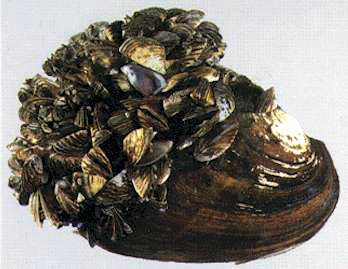Assignment - Seminar 9
Personal activity: no report
Interspecific competition
Save
the clams!
In 1988 a small
bivalve, Dreissena polymorpha (zebra mussel),
was introduced into
lake St. Clair (Ontario), probably from the ballast water of cargo
ships arriving
from the Baltic Sea. In the years that followed, the species rapidly
expanded
its range from the point of introduction, spreading primarily to the
south,
but also to the east and west, both in Canada and the US. The invaded
lakes, rivers and streams were impacted in many ways by Dreissena,
including intense competition for space and food (suspended particles)
between Dreissena and native clams. There is concern that
populations
of native clams
might be outcompeted by Dreissena, and given the broad
distribution
of Dreissena some native clam species might even be threatened
of
extinction.
You are responsible
for managing
Lotsalakes National Park and preserving
the native aquatic species found therein. There is concern that Dreissena
polymorpha might soon reach the lakes in this park. If that
happens, Dreissena
would certainly compete with the one native clam species present in the
park, the unionid clam Anodonta
imbecillis. To prepare for this eventuality, you are asked to
predict
whether Anodonta imbecillis would be extirpated from the park
as
a result of competition with Dreissena polymorpha if Dreissena
did invade Lotsalakes National Park at some future time. |
 |
To determine the outcome of
competition
between these species in Lotsalakes
Park, you set up 20 large tanks near one of the lakes, each tank having
a total surface area of 100m2. To ensure that the
conditions in the tanks are as similar as possible to those in the park
lakes, you line the bottom of each tank with a thick layer of sediment
from nearby lakes. You also install pumps that will fill each tank with
water from the lakes and then maintain a continuous flow of water from
the lakes to the tanks. You then add bivalves to each tank as
follows:
The first 5 tanks (Treatment A) each receive a few Anodonta,
but no Dreissena. The Anodonta
population in each tank is allowed to grow
freely for the duration of the experiment.
In the next 5 tanks (Treatment B) you place some specimens of both
species. However, you check regularly to maintain the abundance of Dreissena
at 500 individuals per tank throughout the experiment by occasionally
adding
or removing Dreissena as needed; the number of Dreissena in each of these tanks
always remains at 500. The abundance of Anodonta
in these tanks, however, is allowed to grow freely.
The third set of 5 tanks (Treatment C) also receive some specimens
of both species at the start of the experiment. In this case, however,
the abundance of Anodonta is maintained at 40 per tank and the Dreissena
population within each tank is allowed to grow freely.
Finally, the last set of 5 tanks (Treatment D) receives only Dreissena.
The population in each of these tanks is allowed to grow freely for the
duration of the experiment. |
You run the experiment for 4 years, keeping track of population
abundances in each tank. At the end of the experiment you record the
following:
In the tanks of Treatment A, the abundance of Anodonta
gradually
increased up to an average of 82 clams per tank and then remained
stable
at that level for the rest of the experiment.
In Treatment B, the abundance of Anodonta gradually stabilized
at an average of 75.6 clams per tank.
In Treatment C, the abundance of Dreissena eventually
stabilized
at an average of 5100 mussels per tank.
Finally, in Treatment D, the abundance of Dreissena increased
to an average of 6460 mussels per tank and remained stable at that
level. |
What do you conclude from these experiments? Should we be concerned
for the Anodonta imbecillis populations in Lotsalakes National
Park
if Dreissena polymorpha were to be introduced to these lakes? Your
solution of this assignment must include a full analysis using the
graphical
method.
1. Determine all the parameters of this
scenario of competition (show
your full calculations).
2. What would be the outcome of
competition between Dreissena
and Anodonta? Include one or more fully labelled
figures to
illustrate
your results, and be sure to provide a detailed explanation of what the
figures mean. Explain how each of the different parameters of the
populations affect
the outcome.
3. Since Anodonta is a
filter-feeder, some park officials have
suggested that, if competition with Dreissena were to be a
problem,
nutrients (N and P) could be added to the lakes periodically. The
idea
is that increased nutrients would increase the production of
phytoplankton
and therefore increase the carrying capacity for Anodonta,
which
might help it overcome competitors. You decide to examine this by
adding
nutrients to another set of experimental tanks and you find that added
nutrients would increase phytoplankton growth, and that this would
increase
the carrying capacity for Anodonta by 19%. Dreissena,
however,
is also a filter-feeder and the increased phytoplankton would enhance
the
carrying capacity for
Dreissena by 14%. Would the addition of
nutrients
be a good idea? Support your answer with calculations and a
state-space
graph. [Hint: a change in carrying capacities would not affect
the coefficients of competition.]
Notes:
|
-If
you predict coexistence of the two species in questions 2 or
3
above, determine the population densities at which each population will
stabilize.
-You will not need Populus to
complete this assignment.
-Show your calculations.
-The
above links to information on Dreissena
and Anodonta are for your
information only. |
